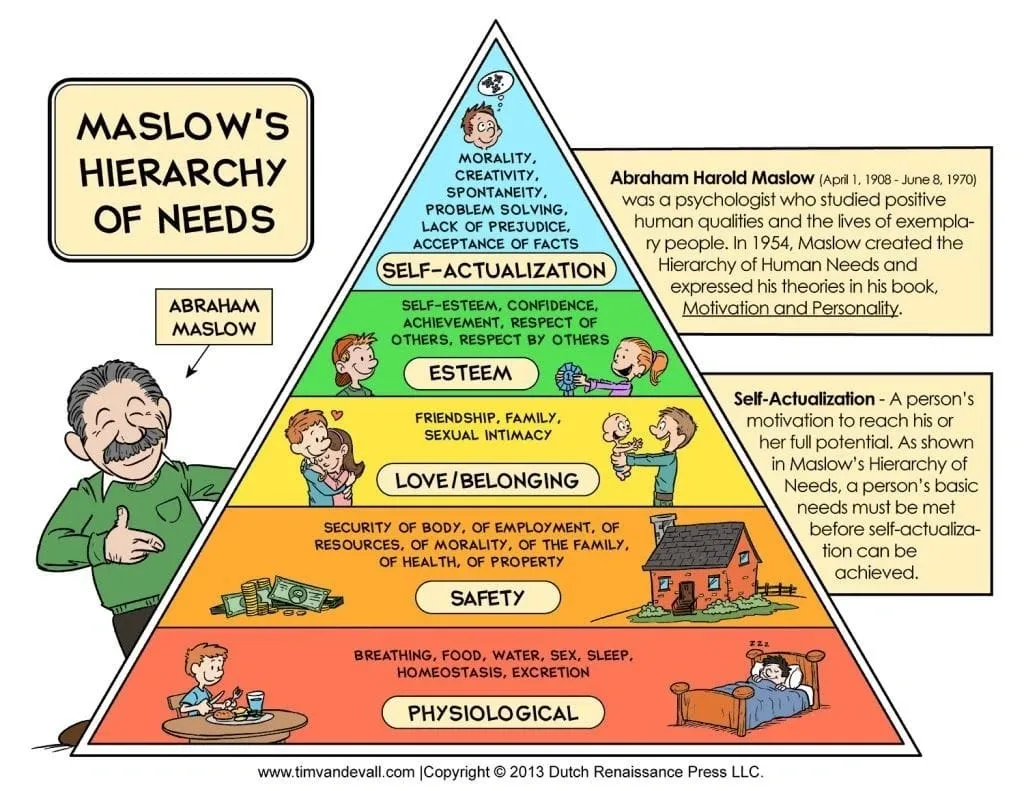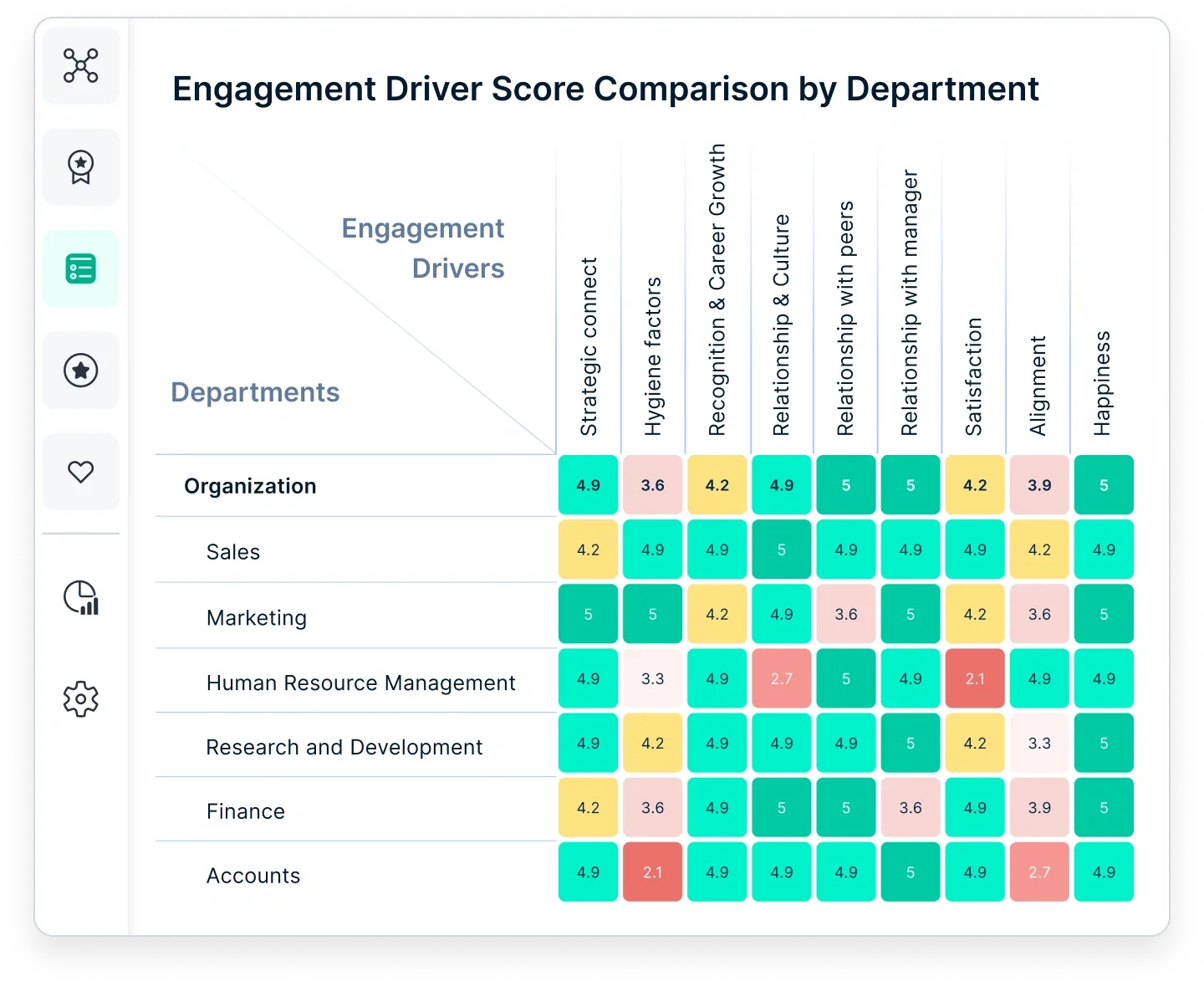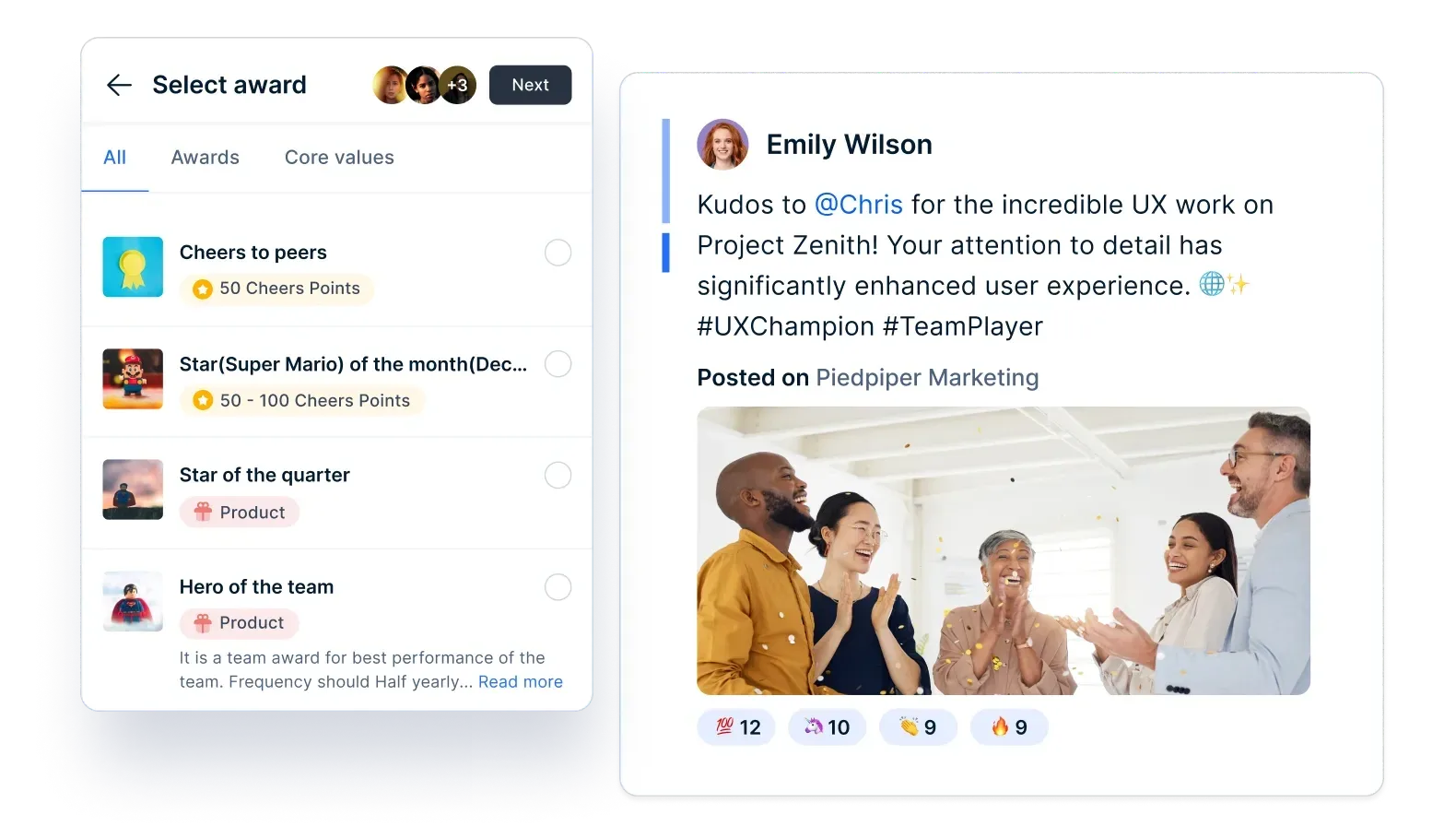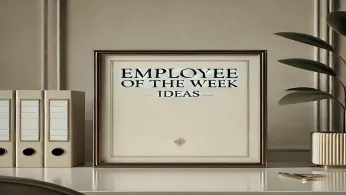11 Proven Employee Engagement Strategies to Boost Productivity in 2025
Explore 11 powerful employee engagement strategies to enhance productivity, boost morale, and retain top talent. Create a motivated workforce with these actionable insights.
في هذه الصفحة
- Understanding employee engagement
- Benefits of a highly engaged workforce
- Types of employee engagement techniques
- 11 Employee engagement strategies you must implement in 2025 to boost productivity
- 5 Common employee engagement mistakes to avoid
- Essential tools assess employee engagement
- استنتاج
- الأسئلة الشائعة
As per a report a staggering $8.9 trillion (about $27,000 per person in the US) is drained from the global economy due to low employee engagement—imagine the transformative impact of unleashing this untapped potential with the correct employee engagement strategies.
Employee engagement is more than a buzzword—it's a driving force behind organizational success. Imagine a workplace where employees are not just clocking in but are genuinely invested, motivated, and passionate about their roles.
This level of engagement doesn't happen by accident; it requires intentional strategies and a deep understanding of what truly motivates your workforce. In today's competitive business landscape, where the cost of disengagement is measured in billions, ensuring that your employees feel valued and involved is not just important—it's essential.
This blog will share a few simple employee engagement strategies that every team member expects from their leader, and if you provide them, then even in today’s fast-paced, ever-changing, highly mobile, and distributed world, they will work to help create highly engaged teams.
Understanding employee engagement
Employee engagement is a critical factor in driving organizational success. It’s much bigger than just job satisfaction—it’s about creating a highly productive and driven workplace environment. Understanding the components and benefits of employee engagement is the first step in developing effective strategies that foster a highly engaged workforce.
As per an article by Forbes, employees tend to leave an organization when they feel ignored or overlooked. Keeping this in mind, let’s have a look at the various aspects of employee engagement and learn management techniques for employee engagement in contemporary organizations.
At its core, employee involvement techniques revolve around several key components: emotional commitment, job satisfaction, and a sense of purpose. Employees who are emotionally committed to their organization are more likely to put in discretionary effort, go the extra mile, and remain loyal to the company.
This sense of purpose, when aligned with the company’s mission and values, forms the foundation of a highly engaged workforce. There are three primary types of employee engagement based on employee attitudes and performance:
- Actively engaged: Employees who are passionate about their work and dedicated to the company's goals. They spread positivity and serve as brand advocates.
- Not engaged: Employees who only complete required tasks, show little interest in the company, and lack proactivity.
- Actively disengaged: Unhappy employees who underperform spread negativity, and discourage others. They are the least engaged.
Benefits of a highly engaged workforce
A highly engaged workforce is a powerful asset to any organization. Engaged employees are more productive, exhibit higher levels of innovation, and contribute to better overall business performance.
Additionally, companies with high employee engagement tend to experience lower turnover rates, increased customer satisfaction, and improved profitability. Investing in employee engagement is, therefore, an investment in the future success of your organization.
As per an article by Indeed, employee engagement tools and techniques lead to an increase in employee retention, increase in customer satisfaction, contribution to innovation, and enhanced company culture.
The research was conducted by Harvard Business Review, wherein a total of 568 individuals participated in the survey, all of whom were employed by organizations with 500 or more employees. Over 42 percent of these respondents came from companies with 10,000 or more employees.
The survey had a global reach, with companies headquartered in North America (54 percent), Asia (18 percent), Europe (16 percent), the Middle East and Africa (7 percent), and South/Central America (5 percent).
Respondents represented a diverse range of industries: 16 percent were in IT/telecommunications, 14 percent in financial services, 12 percent in manufacturing, 9 percent in energy/utilities, 8 percent in healthcare, 8 percent in education, and the remaining 33 percent were from various other sectors.
Seventy-one percent of respondents consider employee engagement to be crucial for overall organizational success. Additionally, seventy-two percent believe that recognizing high performers has a significant effect on employee engagement. However, only twenty-four percent of respondents feel that employees in their organization are highly engaged.
Employee engagement has surged to the forefront of business priorities for senior executives. In today’s fast-paced economy, leaders understand that fostering a high-performing workforce is crucial for both growth and survival.
They acknowledge that a highly engaged team can drive innovation, boost productivity, and enhance financial performance, while also cutting costs associated with hiring and retention in a competitive talent market. Despite this awareness, many executives struggle to find effective ways to measure and address engagement.
However, a growing number of leading companies are gaining a competitive edge by implementing metrics and practices that quantify and enhance the impact of their engagement strategies on overall business outcomes.
The research reveals a disconnect between executive optimism and middle management’s perception of employee engagement. While top executives are generally more positive about engagement levels, three-quarters of those surveyed reported that most employees are not highly engaged, pointing to a significant gap in understanding between executive and middle management perspectives.
Moreover, many companies face challenges in measuring engagement and linking it to financial performance, with fewer than 50 percent effectively correlating employee engagement with metrics such as customer satisfaction or market share.
Yet, a group of companies identified as “high prioritizers” have successfully employed metrics and shared best practices to connect engagement efforts with business performance.
Types of employee engagement techniques
To foster engagement, organizations must implement a variety of techniques tailored to their unique culture and employee needs. Here are some proven strategies:
1. Regular feedback and recognition: Employees need to know how they’re doing and that their efforts are recognized. Regular feedback—both positive and constructive—helps employees improve and stay aligned with organizational goals. Recognition programs, whether formal or informal, show appreciation for employees’ hard work and achievements, boosting morale and motivation.
2. Professional development opportunities: Providing opportunities for learning and growth is key to keeping employees engaged. When employees see a clear path for career advancement, they are more likely to stay motivated and committed. Offering training programs, mentorship, and career development resources can help employees build new skills and advance within the organization.
3. Work-life balance initiatives: Maintaining a healthy work-life balance is essential for employee well-being and engagement. Organizations can support this by offering flexible work arrangements, promoting the use of paid time off, and providing wellness programs. When employees feel their personal and professional lives are in harmony, they are more likely to remain engaged and productive.
4. Employee involvement in decision-making: Giving employees a voice in decision-making processes empowers them and fosters a sense of ownership and responsibility. Involving employees in discussions about company policies, projects, and goals not only leads to better outcomes but also strengthens their commitment to the organization.
11 Employee engagement strategies you must implement in 2025 to boost productivity
These strategies aren’t just ideas on paper—they’re practical ways to create a workplace where people feel connected, valued, and inspired to do their best work. Use these employee engagement strategies to retain your top performers and make them more productive.
1. Clear Direction: Catalyst to a successful employee engagement strategy
The first thing we need to do is to give people a clear direction. If you do not know what the goal and objects of the tasks are, then people can't be able to connect with them. When people lack clarity and direction, it’s difficult for them to become engaged, if not impossible. We should also look to clarify not only what we are doing but also why it is important and if we can explain why, it is important to them, then that’s even better.
As part of the program we were running at Fujitsu, we were moving a client to a new IT platform, so we looked to highlight to the team that they would be the first in the company to gain skills within this new technology which would help give them a competitive advantage and put them in demand for future projects.
2. Creating a safe environment
Nothing kills an effective employee engagement strategy faster than having a blame culture. I see this time and time again where people are criticized for mistakes, and demeaned in front of others for any tiny mishap.
This is a morale killer, it not only stops people from taking risks, but they also look to keep out of the firing line and do the minimum that is required of them, and if it gets too toxic, then they become disengaged completely.
Good leaders create a safe environment where people don’t feel afraid of making mistakes because that fear can lead to hesitation and mistakes. If mistakes happen, then focus on finding solutions, not who’s to blame, and give any feedback in a supportive way that will help people improve rather than highlighting their shortcomings, and also do it in private. Public autopsies of individual failure only make people warier of mistakes.
3. Set them up for success
Ever heard the phrase, “Success has a thousand fathers, but failure is an orphan child” this is one of my favorite sayings because it shows that everyone wants to be part of a winning team.
We all want to feel that we have achieved something, to experience success, and to get rewards and recognition. We are hard-wired for this, one of our basic needs is to have good self-esteem and a little bit of success serves to fill that need.
So, if we can show our teams how to be successful, if we give them the tools, they need to be successful, then not only will they become engaged, but they will become excited to be involved.
الناس لا يخافون من العمل الشاق - إنهم يخافون من الفشل ، وعندما نتمكن كقادة من منحهم الثقة بأنهم سينجحون ، فعندئذ في تجربتي ، سيعملون بجد لتحقيق ذلك.
4. Give them space to be successful
Whilst I believe that blame is one of the worst things for killing engagement, I must admit that Micro-Management is a very close second. Even with distributed teams, I have seen people become disengaged by managers constantly chasing them up through chats, emails, and phone calls.
It sometimes feels that Micro Managers see virtual teams and people 1000 miles away from them as some challenge and look for new and better ways to keep a close eye on them. Even though we might be working at home, it feels like Big Brother is still watching you.
لا تفعل ذلك!
امنح فريقك مساحة. امنحهم فرصة لإحراز تقدم قبل تسجيل الوصول معهم. من الناحية المثالية ، اتفق معهم عندما يكون الوقت مناسبا لك للعودة ومعرفة كيف يفعلون.
عندما تمنح الناس مساحة ، فهذا يدل على أنك تثق بهم. سيشعرون بالاحترام وهذان شعوران سيساعدان في دفع المشاركة.
الآن هذا لا يعني أنه لا ينبغي لنا أبدا تسجيل الوصول. وهذا يعني أنه يجب علينا أن نفعل ذلك في الأوقات المناسبة، ومن الناحية المثالية، في الأوقات المتفق عليها بصورة متبادلة. ولن يساعد ذلك في المشاركة فحسب، بل سيساعد أيضا في دفع المساءلة.
5. Give them support when needed
عندما يتعلق الأمر بجعل الناس يشعرون بأنهم سينجحون ، فإن إحدى أقوى أدواتنا هي إخبارهم بأنهم يحصلون على دعمنا ويمكنهم التواصل إذا لزم الأمر. هذا يشبه إعطاء فنان أرجوحة شبكة أمان ، على الأرجح ، لن يستخدموها ، لكن معرفة وجودها سيساعد على زيادة ثقتهم ، مما سيساعد على تعزيز المشاركة بشكل أكبر.
89% of workers at companies that support well-being initiatives are more likely to recommend their company as a good place to work-American Psychological Association
We should let them know at the start that they can reach out if there are any difficulties or things they are unsure of or need a little help with. This also contributes to creating a safe environment, one where they know that if they start to have issues, not only will they not be blamed or criticized but one where they can get some help.
6. Give them good feedback
مع وجود فرق موزعة بشكل كبير ، نحتاج إلى التأكد من أن قنوات الاتصال واضحة ومفتوحة ومستخدمة بشكل منتظم. نحن بحاجة إلى إجراء مكالمات منتظمة لمشاركة التقدم مع الفرق عندما يرون أنهم ناجحون ، وهذا دافع كبير ويظهر أن جهودهم تنجح. كما أنه يوفر فرصا لتقديم الدعم عندما نحتاج إلى إجراء تغييرات إذا لم تسر الأمور على ما يرام.
Employees feel 5x more empowered if their feedback is valued in the organization. - Salesforce
نحتاج أيضا إلى الثناء على الناس على جهودهم وتقدمهم الجيد. إذا قام الناس بالعمل ولكنهم تلقوا القليل من التعليقات أو لم يتلقوا أي تعليقات ، فيمكنهم الوقوع بسرعة في عقلية "لا أعرف لماذا أزعج" ، وعندما يحدث ذلك ، فإنهم يبدأون الآن في السير على طريق فك الارتباط.
ردود الفعل الإيجابية لا تكلف شيئا ، ولكن العائد على الاستثمار كبير ، وإعطائها بحرية.
نظرا لأن العالم يتغير بشكل متزايد ، ستساعدك هذه الأشياء البسيطة في إنشاء فرق مشاركة. سيعملون مع الفرق التي تقدم تقاريرها إليك مباشرة ؛ سيعملون مع الموردين والموظفين الخارجيين أيضا ، لأنهم يساعدون في تلبية بعض احتياجاتنا الأساسية. كلما أصبحت أفضل في هذه ، كلما أصبحت فرقك أكثر انخراطا وكانت النتائج التي ستحققها أفضل.
7. Tour of duty
غالبا ما تتبع الشركات من جميع الأحجام - كبيرة كانت أم صغيرة - نهجا تفاعليا عندما يتعلق الأمر بالاحتفاظ بالموظفين ومشاركتهم. إنهم يوظفون مهارات جديدة ويفصلون الموظفين لتوفير التكاليف.
يبدو هذا النهج مشروعا ، ويخدم متطلبات العمل على المدى القصير ، ولكنه يؤدي إلى نتائج عكسية على المدى الطويل. يأخذ الموظفون الفكرة من هذه الترتيبات. إنهم يتصرفون مثل الوكلاء الأحرار ويقفزون على الوظائف كلما أتيحت لهم فرصة جديدة.
Reid Hoffman, founder of LinkedIn proposes an adaptive approach in one of his books The Alliance: Managing Talent in the Networked Age. The approach is called ‘the tour of duty’.
The concept comes from the military where officers work on a single assignment or deployment and then move on to the next, defining their entire military career. This helps them grow their skills and experience and avoid reaching an unexpected plateau in their careers. They get to know the entire organization rather than feeling stuck in a single role for years. The organization also gets to develop the talent from an internal pool of employees and solve their succession problems.
في نهج "جولة العمل" ، تتفق الشركة والموظف على التسليمات والتوقعات من بعضهما البعض ، والجدول الزمني للجولة. في نهاية جولة واحدة ، قد يختار الموظف الذهاب في جولة أخرى من الخدمة داخل الشركة ، بدلا من اختيار واحدة مع منافس.
أليس من غير البديهي تشجيع الموظفين على البحث عن مهام جديدة؟ لقد أثبت عالم الشركات الناشئة أن تشجيع الموظفين الرياديين يجعل الموظفين يظلون مشاركين بعمق.
هل سيغادرون إذا فشلت الشركة في تقديم جولة أخرى من الخدمة؟ نعم! لكن الاحتفاظ بهؤلاء الموظفين حتى لفترة أقصر نسبيا قد يوفر فوائد ضخمة للشركة وبالطبع ، إنها استراتيجية فريدة لمشاركة الموظفين.
كيف تختلف "جولة العمل" عن العادية - "التوظيف ، التحقق من الأداء ، الاستمرار أو الرحيل"؟ في حالة "جولة الواجب" ، من الواضح تماما أن الترتيب سينتهي. الوعد للموظف ليس مجرد راتب. إنه يزيد من قابليته للتوظيف.
The duration is pre-decided, and it is usually kept at two years. There is no fuzzy expectation of “being a good employee” and no fuzzy commitment to the employee. Time-limited mutual commitment with clear goals and expectations is the hallmark of ‘tour of duty’. This may seem transactional but is better than buying time for money and driving employee retention via vague notions of loyalty.
8. Alumni networks and employee peer networks
Some of the leading technology companies such as Intuit actively run alumni networks. The benefit is obvious - tap into the network intelligence. At one end, such initiatives enable HR to tap back into the past talent for a rehire or get recommendations on new hires. However, more importantly, companies stand to benefit from the knowledge and information with people outside the company.
قد تملي الحكمة التقليدية تجنب الموظفين السابقين ، وتوقيع عقود صارمة ، والتعامل مع الوجود على أنه دائم. ومع ذلك ، مرة أخرى ، أظهرت الدروس المستفادة من الشركات الناشئة وبعض المنظمات التطلعية شيئا جديدا. إن إشراك موظفيك وخريجيك وشبكات الموظفين مجزية أكثر بكثير من تجنبها دون الحفاظ على مخاوف لا داعي لها.
بناء وتفعيل شبكة موظفيك. علمهم كيفية البحث عن مثل هذه الشبكات والوصول إليها. أبلغ موظفيك عن المعلومات غير العامة مقابل معلومات الملكية. هذا الأخير سري ويجب ألا يترك جدران الشركة.
من ناحية أخرى ، فإن المعلومات غير العامة هي ما يمكنهم تبادله والبحث عنه ، مثل الاتجاهات الأحدث التي يلاحظونها في الصناعة ، والتغيرات في التكنولوجيا ، وما إلى ذلك. شجعهم على حساب وجبات الطعام مع الغرباء وفي المقابل مشاركة ما تعلموه داخل الشركة.
قم بإنشاء شبكة خريجين على LinkedIn ، وقم بتنظيم الأحداث الكبرى في مقر الشركة ، وادع المؤثرين للتحدث ، وقدم تذاكر مجانية لخريجيك وضيوفهم. اغتنم كل فرصة لبناء العلاقات.
إذا لم يكن لديك موارد كافية لتنفيذ مثل هذه البرامج التفصيلية ، فما عليك سوى الذهاب حول الطاولة ، وطلب المعلومات الجديدة التي صادفها الفريق مؤخرا. وفي المقابل ، ما عليك سوى تقديم تقدير صادق لمشاركة هذه المعلومات التي ربما جمعوها من الخريجين أو شبكتهم الخاصة. في النهاية ، سيبدأ الموظفون في التعرف على الشبكات وإدارتها بنشاط.
9. Employee well-being support mechanisms
سواء أعجبك ذلك أم لا ، سواء كنت تريد الاعتراف بذلك أم لا ، فإن موظفيك يأتون إلى العمل بينما يكافحون التحديات في حياتهم الشخصية. العلاقات المحطمة ، والقضايا الصحية الرئيسية ، وأفراد الأسرة المصابين بأمراض قاتلة ؛ القائمة لا حصر لها عندما يتعلق الأمر بالتوازن بين العمل والحياة.
ستوجهك الحكمة الشائعة إلى توقع أن يأتي الموظفون دون أن يتأثروا بالعمل وأن يحققوا أهدافهم وتألقهم بنسبة 100٪. ومع ذلك ، بصفتك قائد الموارد البشرية ، فأنت تعلم أن مبادرات وبرامج المشاركة الخاصة بك ربما لا تمنحك النتائج المرجوة لأنك لا تتواصل مع موظفيك بعمق كاف.

Source: Dan Martell
تذكر باتي أزاريلو ، وهي قائدة شركة سابقة وهي الآن مستشارة أعمال ومدربة ، أنها تمكنت من زيادة مشاركة وأداء أعضاء فريقها بسؤال بسيط "ما الذي تريدني أن أقلق بشأنه؟".
من خلال هذا السؤال البسيط ، خلقت بيئة موثوقة للناس للانفتاح ومشاركة نقاط ضعفهم في الحياة الشخصية والروابط العاطفية التي كانت تؤثر على أدائهم. ثم واصلت تسهيل مساعدة الموظف على الخروج من التحدي من خلال تقديم الدعم.
كيف يمكنك بصفتك قائد الموارد البشرية وضع مثل هذه الاستراتيجيات في مؤسستك وإضفاء الطابع المؤسسي عليها؟ فكر في إشراك الخبراء - سواء كانوا مدربين للحياة أو مدربين مدربين من منظمات روحية معترف بها عالميا أو محامين أو أطباء ، إلخ ، ممن يقدمون المهارات الحياتية ومشورة الخبراء على أساس منتظم.
توفر البرامج الرسمية مثل هذه التي تتم باستمرار للموظفين فرصة للتعمق والاستفادة القصوى من هذه المرافق. لا تقم فقط بتنظيم فحوصات الأسنان. تجاوز واستثمر في موظفيك بطريقة منظمة وبشكل أعمق. بالتأكيد ، ستكون هناك تكلفة مرتبطة.
لكن فكر في تكلفة الاستنزاف وتكلفة فك الارتباط الضخمة. توفر مثل هذه البرامج للموارد البشرية الفرصة لتحسين تجربة الموظف والإنتاجية والمشاركة في الوظيفة والمقاييس الأخرى المرتبطة بها والتي تؤثر بشكل مباشر على ربحية الشركة.
10. Businesses know-how
الناس ، بشكل عام ، عالقون في عالمهم الصغير - أصدقاء محدودون ، وقضايا محدودة عن الحياة ، والعمل. مع هذا الرأي ، حتى مشكلة صغيرة تفترض اضطرابا كبيرا. ولكن بمجرد أن ندرك حقا مدى اسمية وجودنا على الكوكب والمجرة ، نحصل على منظور أكبر وأحدث حول حياتنا. مماثل هو الوضع في أماكن العمل الحديثة.
على الأرجح ، الموظفون في مؤسستك مشغولون بوظائفهم الأساسية - يوما بعد يوم ، دون معرفة ما يحدث في الفرق والأقسام أو المناطق الجغرافية الأخرى. قد لا يهتم أحد أعضاء الفريق الفني بكيفية ترويج التسويق لمنتجات برامج الشركة. وقد لا يكون مندوب المبيعات مهتما بكيفية مواجهة الخدمات اللوجستية للتحديات المتعلقة بالمخزون والاختلاس.
ربما كل ما يعرفونه هو عبر النشرة الإخبارية من الرئيس التنفيذي. وبيئة العمل المنعزلة هذه تجعل عالمهم صغيرا جدا داخل الشركة. هذه الرؤية المحدودة حول عملهم وعمليات الشركة تجعل من السهل التعثر ويمكن أن يحدث فك الارتباط في أي وقت. يتعثر الموظفون مع مضايقات بسيطة للغاية وقد ينتهي بهم الأمر إلى ترك وظائفهم أو ضعف الأداء.
There is a way out of this. Make them see the larger picture. Make them see where their job fits into the money-making for the company. Help them understand how the company fits into the overall industry and how perhaps the industry is fairing with the overall economy.
Encourage them to teach and share business know-how. Formalize routine programs where such know-how exchange happens. Document and socialize these learnings. Start with understanding the nuances of your company.
As the business book author Josh Kafuman outlines, to understand any business, know the five core parts of any business - value creation, marketing, sales, value delivery, and finance.
يتعلق خلق القيمة بإنشاء منتج أو خدمة لتقديمها للعملاء ، والتسويق يدور حول إثارة اهتمام العملاء ، والمبيعات تدور حول تسجيل العملاء وقبول الأموال ، وأخيرا يتعلق تسليم القيمة بتقديم المنتجات والخدمات التي دفع العملاء مقابلها.
قم بتطبيق نفس النموذج لفهم الأنشطة التجارية المشابهة لنشاطك التجاري. ستساعد هذه النماذج التأسيسية الموارد البشرية على فهم الأعمال بأنفسهم وحشد دعم القادة والمديرين لتحسين المعرفة التجارية لجميع الموظفين ، وبالتالي خلق معنى حول وظائفهم.
11. Inter-team collaboration
ليس فقط في الشركات الكبيرة ، ولكن حتى في الشركات التي تضم 150+ موظفا ، تتنافس الفرق أكثر مما ينبغي أن تتعاون مع بعضها البعض. هذا هو أحد مجالات المشاكل الرئيسية التي يواجهها قادة الأعمال وهو ذو أهمية قصوى في تحسين تجربة الموظف.
يمكن لقادة الموارد البشرية أن يلعبوا دورا رئيسيا في مساعدة قادة الأعمال على تحقيق التعاون المطلوب بين الفرق ووحدات الأعمال وتحسين إنتاجية المؤسسة بأكملها. تقدم الفرق عطاءات لنفس المشاريع وتتنافس للحصول على حصة كبيرة.
يحاولون توظيف وبناء المهارات لأنفسهم بدلا من استعارة تلك من فرق أخرى. في نهاية المطاف ، تنحرف مجموعات المهارات في المنظمة بأكملها ، ويجد قادة الأعمال أنفسهم في صعوبة في نضج المنظمة بمهارات أكثر صلة لتقديم فرص عمل جديدة. من الذي يطلب منه بعد ذلك حل لغز المهارات هذا؟ أنت ، قائد الموارد البشرية!
تحدث مثل هذه السيناريوهات من عدم التعاون والمنافسات بين الأقسام حيث لا تفهم الفرق الأدوار التي تلعبها لخلق القيمة وتقديم القيمة. قد يفهمون على مستوى المعلومات ، لكنهم ربما لم يستوعبوا تحديات الفريق الآخر وتفرده. اغتنم هذه الفرصة واجعلهم يرتدون قبعات بعضهم البعض أو يدخلون في أحذية بعضهم البعض.
5 Common employee engagement mistakes to avoid
Many managers unknowingly adopt strategies that harm employee engagement. Here are some common mistakes that reduce workplace morale and productivity.
1. Setting unrealistic expectations and threatening job security
Managers often set unattainable goals and use threats like job termination or pay cuts to enforce them. A CBC report highlighted how TD Bank employees faced immense pressure to meet unrealistic sales targets, leading to unethical upselling. While managers may believe this boosts productivity, it increases stress, lowers engagement, and contributes to high turnover.
2. لعب المفضلة
Favoritism is widespread in workplaces, where managers grant special privileges based on personal relationships. A study of U.S. business executives found 56% favored certain employees for promotions, while 30% of HR professionals acknowledged favoritism in their organizations. This practice lowers morale, engagement, and job satisfaction while increasing turnover and workplace conflict. Effective leadership requires fairness and transparency to maintain a motivated workforce.
3. الإدارة التفصيلية للموظفين
Some managers excessively control their employees' work, undermining trust and creativity. Micromanagement leads to disengagement, as employees feel undervalued and restricted.
4. عدم التعرف على الموظفين
Many managers overlook employee recognition, often citing time constraints or skepticism about its necessity. However, a SHRM study found that 84% of employees believe recognition positively impacts engagement. A culture of recognition boosts morale, productivity, and job satisfaction.
5. تقديم حوافز لا معنى لها
While incentives are essential, they must be meaningful. Vague or unclear bonus structures leave employees feeling undervalued.
The Business Journals suggest structured performance-based incentives that are "clear, measurable, and realistic." Employers should offer a mix of financial and non-financial rewards tailored to employee preferences.
Instead, employers should offer more meaningful incentives to employees by providing a wide range of incentives. Meaningful incentives can help to boost morale, improve productivity, and motivate employees to continue performing well. Employers need to give employees a choice to select their preferred motivations.
For example, on Empuls global catalog of incentives, employees can choose from several options to find what motivates them.
Essential tools assess employee engagement
To effectively assess and enhance employee engagement, organizations can utilize various tools such as surveys, social intranet platforms, and feedback mechanisms.
1. Pulse surveys and feedback platforms: Regularly gathering employee feedback through pulse surveys and other platforms allows organizations to stay attuned to employee sentiments and needs. These tools can provide valuable insights into areas where engagement is strong and where it may be lacking, enabling timely interventions and improvements.
كيف يمكن Empuls المساعدة؟
With Empuls, you can understand employee satisfaction levels and uncover the reasons behind the scores. Dive deeper to get insights into attrition, assess motivation, uncover team performance, gauge happiness, and measure workflow efficiency.

Leverage real-time sentiment analysis and benchmarked heat maps to understand the areas of improvement and develop a plan of action.
2. Employee recognition software: Implementing employee recognition software can streamline the process of acknowledging and rewarding employees’ contributions. These platforms often include features like peer-to-peer recognition, points-based rewards systems, and automated recognition for milestones, making it easier for organizations to celebrate success consistently.
كيف يمكن Empuls المساعدة؟
With Empuls, you can recognize your colleagues with multiple award types. There’s value badges, spot awards, and peer awards for in-the-moment recognition.

Use Approval-based awards to seek nominations and include jury panels. Share performance and incentive-based awards for various types of goals.
3. Internal communication tools: Effective internal communication tools, such as intranets, chat platforms, and project management software, help keep employees connected and informed. By facilitating seamless communication across teams and departments, these tools contribute to a more collaborative and engaged workforce.
كيف يمكن Empuls المساعدة؟
Align everyone with your culture with Empuls. Keep everyone on the same page by sharing company news. Build trust with two-way, transparent communication. Communicate how everyone can contribute to your culture and vision.
Celebrate every achievement, big and small, as a team. Engage with interactive content formats: gifs, polls, videos etc.
4. Learning management systems: Learning management systems (LMS) offer employees access to a wide range of training and development resources. An LMS can be used to deliver online courses, track learning progress, and provide certifications, helping employees continuously develop their skills and knowledge.
استنتاج
Employee engagement is essential for organizational success. By implementing techniques like clear communication, regular feedback, professional development, and work-life balance initiatives, organizations can create a highly engaged workforce.
It’s important to remember that there is no one-size-fits-all approach to employee engagement. Organizations must adapt these techniques to their unique culture, goals, and employee needs to achieve the best results.
To build a more engaged and motivated workforce, start by implementing these proven employee engagement techniques. If you’re ready to take the next step, get in touch with culture experts to help you develop a tailored engagement strategy that drives success.
For personalized support in developing your employee engagement strategy, get in touch with the culture experts at Empuls.
الأسئلة الشائعة
1. What are the 5 C's of employee engagement?
The 5 C's of employee engagement are:
- Clarity – Ensuring employees understand their roles and company goals.
- Confidence – Empowering employees with the right tools and training.
- Convey – Encouraging open communication and feedback.
- Connect – Fostering strong relationships and teamwork.
- Congratulate – Recognizing and rewarding achievements.
Implementing these 5 C’s is a key employee engagement strategy to improve productivity and workplace morale.
2. What are the 4 types of employee engagement?
The 4 types of employee engagement are:
- Highly Engaged – Passionate and committed employees.
- Moderately Engaged – Satisfied but not fully invested.
- Barely Engaged – Minimal effort and motivation.
- Disengaged – Unmotivated and likely to leave.
Adopting effective strategies for employee engagement can help move employees toward higher engagement levels.
3. What are the 4 P’s of employee engagement?
The 4 P’s of employee engagement are:
- People – Building strong teams and relationships.
- Purpose – Aligning employees with company mission and values.
- Progress – Providing growth opportunities and career development.
- Praise – Recognizing and rewarding contributions.
These elements form the foundation of strategies employee engagement, ensuring a motivated and committed workforce.













